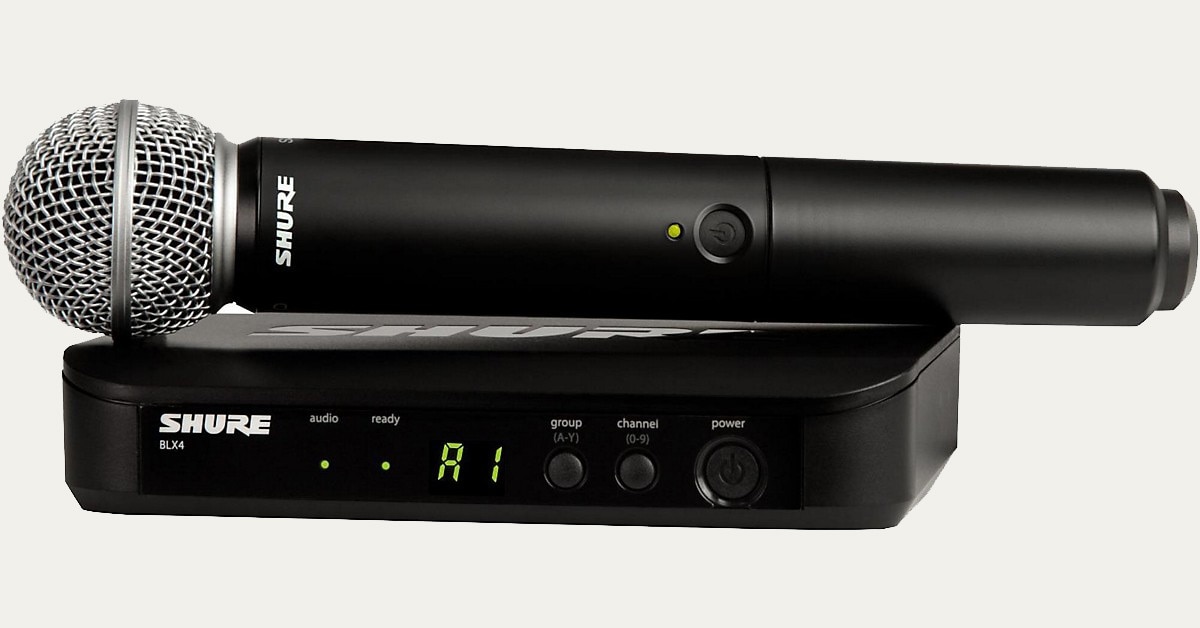Looking for a wireless audio system but not sure where to start? We're here to help.
Table of Contents
Why Wireless?
The History of Wireless Audio Systems
Wireless Microphone System Components
Types of Wireless Systems
Key Wireless Receiver Functions and Features
Wireless In-Ear Monitoring Systems
Things to Consider in Finding the Right Wireless System
Why Wireless?
Wireless systems have an obvious benefit: freedom of movement onstage. Unencumbered by instrument or microphone cables, or the need to stay close to monitor speakers, you’re free to roam the performance space. For active performers and presenters this can be a big advantage. Wireless systems also can be faster to set up, and help minimize the clutter of cables, mic stands, and floor monitors that crowd performers. Of course, their benefits aren’t limited to stages; you’ll find wireless systems in houses of worship, lecture halls, theaters, dance and exercise studios—anywhere presenters, instructors, or performers are looking for freedom of movement.
Wireless systems have grown increasingly popular along with improvements in their sound, reliability, and affordability. In this guide we’ll walk you through the various types of wireless systems and the features to look for in making the right choices.
The History of Wireless Audio Systems
Several individuals and companies have made competing claims that they invented the first wireless system. The earliest wireless mic schematics and do-it-yourself kits appeared in hobbyist magazine such as Popular Science and Popular Mechanics in the mid-1940s. From the late ‘40s through the early ‘50s various tinkerers created “wireless radio microphones” that transmitted signals using radio frequencies. These systems showed up sporadically in theatrical and sporting events.
The Shure Brothers laid claim to having the first wireless microphone system for performers. Called the Vagabond, it had a very limited range of about 15 feet. In 1957, a German company called Lab W, later to become Sennheiser, created a wireless system that had a range of about 300 feet.
An American electrical engineer, Raymond A. Litke, developed a wireless microphone system in 1957 that was used in various applications such as the Olympic trials in 1959 and the 1960 Democratic and Republican conventions. He was granted the first wireless system patent in 1964. A version of the system was introduced later that year by Vega Electronics and was marketed as the Vega Mike.
Sony introduced its first wireless microphone system, the CR-4, in 1958, and by 1960 it was the system of choice for many theatre performances and nightclub acts. German manufacturer, Beyerdynamic, was also successful during this era with its wireless technology that was used in 1964 to capture the soundtrack for the filmed version of the musical My Fair Lady.
In the mid 1970s companding technology developed by Nady Systems resulted in wireless systems with a wider dynamic range. This led to their adoption by stadium acts such as Todd Rundgren and The Rolling Stones.
Today, almost every large venue uses wireless systems, dramatically changing the dynamics of performance. In 1996 a joint Emmy Award for "pioneering the development of the broadcast wireless microphone" went to Nady, CBS, Sennheiser, and Vega.
Wireless Microphone System Components
All wireless mic systems, regardless of their applications, are made up of two basic components: transmitters and receivers. Transmitters convert the audio signal captured by the mic into a radio signal. These are then sent to a receiver that converts them back to an audio signal that is then sent to the sound system.
First, we’ll look at the various types of mic transmitters.
Handheld Microphone Transmitters
These wireless mics incorporate the transmitter into their handle so both functions are contained in a single unit. As with wired handheld mics, there are numerous wireless dynamic and condenser mic models to choose from that will match just about any performer’s needs. Some manufacturers offer separate transmitters that can be plugged into the XLR connector of any dynamic mic, making microphone options even more plentiful when going wireless.
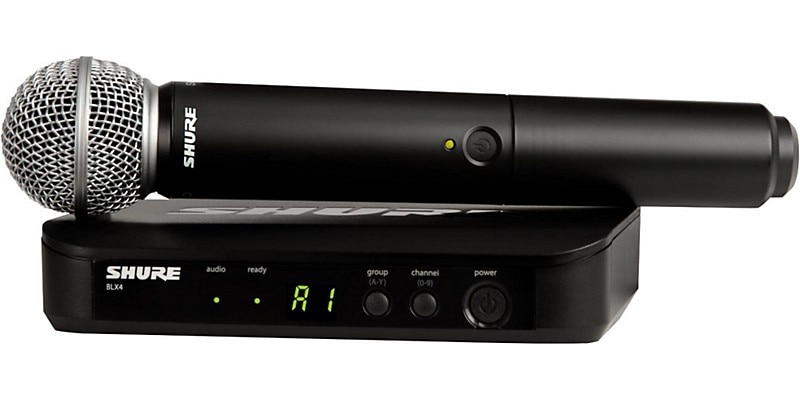
The Shure BLX24/SM58 Handheld Wireless System with SM58 Capsule includes a BLX4 receiver which is a lightweight, durable ABS polymer chassis. It has a smaller footprint than previous receivers, and features an enhanced group and channel scan. Equipped with true diversity and a rugged build quality, this easy to use wireless receiver brings unprecedented quality into this price range.
Bodypack Transmitters
These units clip onto clothing or guitar straps and can be used with lavalier or headworn vocal mics, or with clip-on and plug-in instrument mics as detailed below.
Lavalier vocal mics usually attach to clothing, come in a range of sizes, and are used to capture dialog in TV and film production as well as for some public -speaking settings.
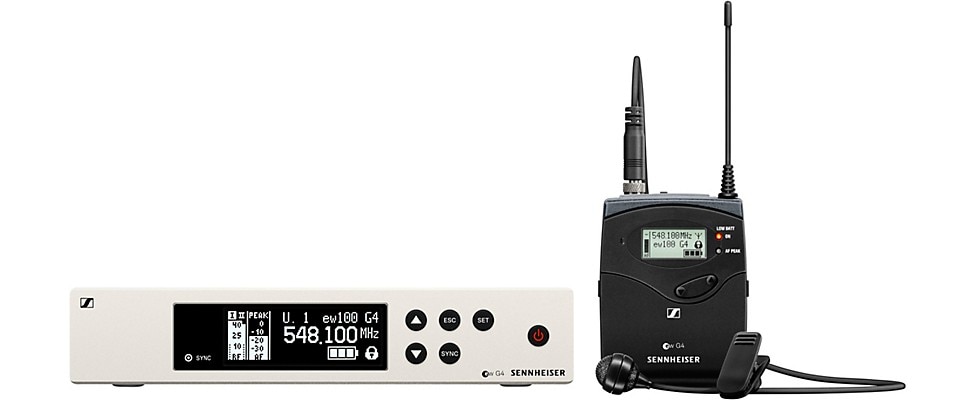
The Sennheiser EW 100 G4-ME2-A Wireless Lavalier Mic System A includes a G4 rack receiver, SK 100 bodypack transmitter and ME2 lavalier microphone.
Headset vocal mics offer consistent, high-quality sound pickup, have a headband, and are easy to position for use during highly active performances.
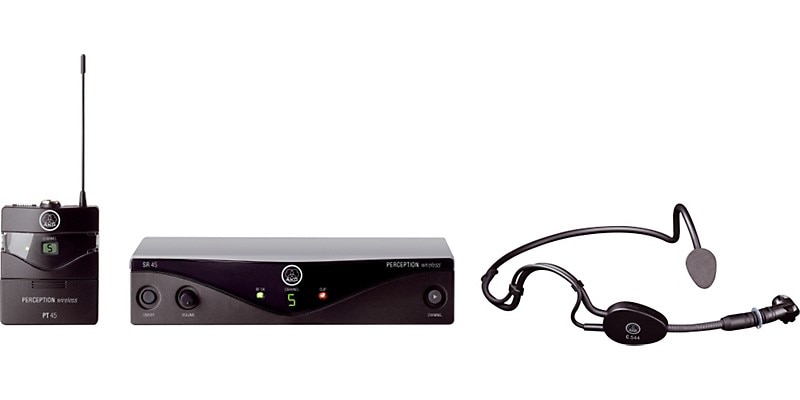
The AKG Perception Wireless Sports Set includes a comfortable C 544 L headset and lightweight PT 45 bodypack transmitter, ensuring maximum user mobility.
Clip-on instrument mics clamp to the body or bell of wind, brass, orchestral string, or percussion instruments, providing consistent sound pickup due to their fixed positioning.
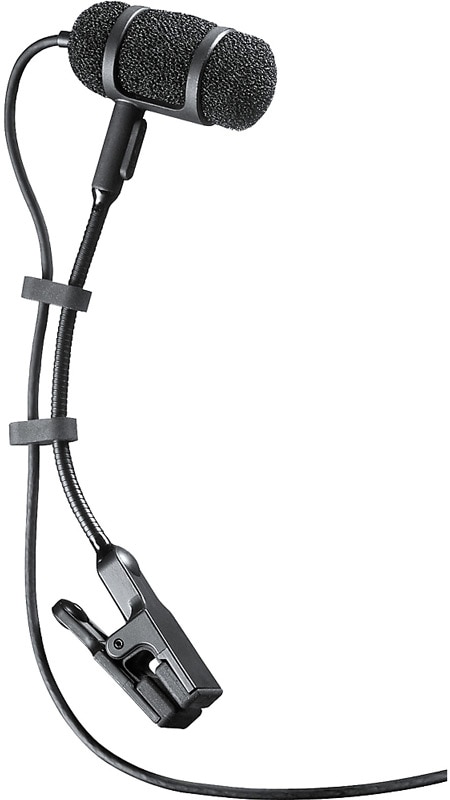
The Audio-Technica PRO 35 is a versatile wireless condenser mic that can handle a broad range of high-output sources including saxophones, percussion and brass.
Plug-in systems for electric bass and guitar often have a short cable that plugs into the instrument’s output jack, connecting the guitar with a bodypack transmitter that clips onto clothing or an instrument strap. Some transmitters have multiple settings for use with either instrument, lavalier, or headworn mics. Both clip-on and plug-in wireless instrument systems have grown in popularity as their reliability has increased while prices have come down.
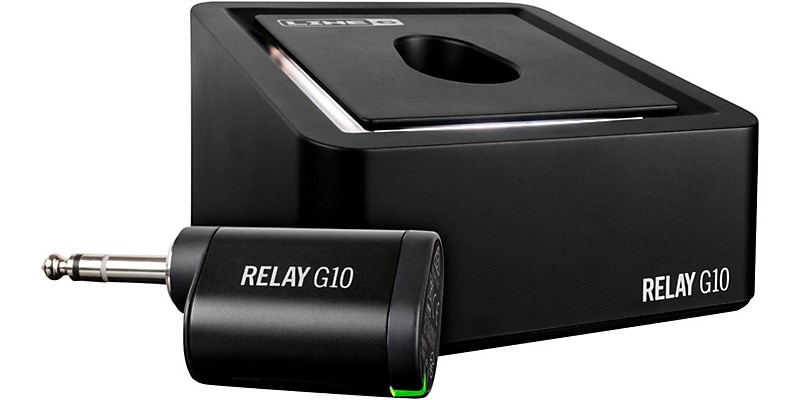
The Line 6 Relay G10 Digital Wireless System offers plug-and-play functionality, 50-foot indoor signal range and 24-bit Relay digital wireless sound quality. What you play is what you'll hear.
Types of Wireless Systems
VHF vs. UHF
Virtually all pro wireless systems operate on either the VHF (very high frequency) or UHF (ultra high frequency) bands. VHF wireless systems generally operate within the 174 to 216MHz range (the range of TV channels 7-13), while UHF uses the 470 to 805MHz range (the range for TV channels 14-69).
Traditionally, UHF has been used by higher-end wireless systems, and has the reputation for having more transmitter range and being less prone to TV interference. These are real advantages but need some qualification.
UHF-based systems are allowed more transmitter power by regulation, but that doesn’t mean that any given system actually has more power than a given VHF system. UHF also has more range than VHF, not because of power, but because the signals move through the atmosphere more easily. UHF also has up to eight times more frequencies available.
As for less interference, that situation is changing. As parts of the UHF range are being assigned to public safety communications and digital TV broadcasting, the band is becoming more crowded. Also, the highest end of the UHF spectrum (above 900MHz) is a general-purpose range used for cordless telephones, garage door openers, and ham radio, so it’s not advisable for wireless use as interference problems are very likely. Actually, both bands are becoming more crowded. As discussed in the next section, digital signal processing technology is playing an important role in dealing with interference.
Analog vs. Digital Wireless Systems
Many wireless systems use a process called companding that compresses the transmitted audio signal at the microphone then expands it at the receiver to restore the dynamic range of the audio. This is done to deal with the limited capacity of wireless channels. Other circuitry is used to detect and remove noise from the transmitted signal. Because systems from different manufacturers, or even different systems from the same manufacturer, have different methods of companding, you should avoid mixing components from different systems, even if they use the same frequency. Unpredictable results can occur.
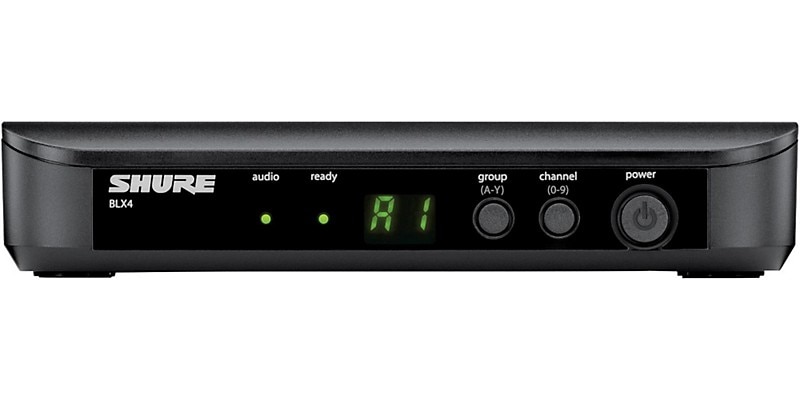
The Shure BLX4 Wireless Receiver works with handheld, lavalier, instrument and headsets, offering professional quality sound, straightforward setup and confuration and great performance at a very affordable price.
Digital wireless systems convert the audio signal captured by the microphone into a digital bitstream at the transmitter then convert the bitstream to an audio signal at the receiver. The main advantage is elimination of the need for companding and the signal degradation such processing can cause. Since the receiver only processes digital ones and zeroes, radio-frequency interference is not a factor. That said, the best high-end analog wireless systems can rival digital systems in terms of their dynamic range and resistance to interference.
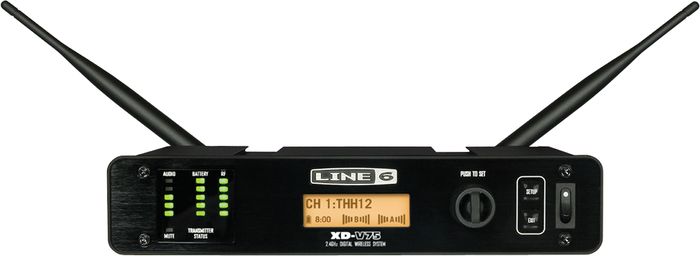
Digital technology assures perfect transmission of vocal or instrument signals, even in difficult environments using the Line 6 XD-V75TR Wireless Bodypack System.
Key Wireless Receiver Functions and Features
The true worth of a wireless system is determined by its overall sound quality, dynamic range, freedom from dropouts and interference, and its operating range. Essentially, you want a wireless system to sound like a wired system. You also want a system that has easy-to-use controls and easy-to-read displays. There are a number of other common features that are true for all wireless mic, instrument, and in-ear monitoring systems that are not so immediately obvious.
Diversity Circuitry
Diversity is all about reception and freedom from dropouts, and most wireless brands tout it as a selling feature. One external sign of diversity is the presence of two antennas on the receiver, although not all dual-antenna receivers have true diversity. Receivers with true diversity circuitry have two separate radio receiver modules, each connected to its own antenna. The signals from the two antennas are monitored and the one receiving the stronger signal is automatically selected. Reception is in part a function of position, and is influenced by the relative locations of the transmitter and receiver. By having two antennas, you reduce the chance of dropouts occurring.
If your system is intended for use in a single location, and especially an open location such as a house of worship, you likely won’t gain much by having a true-diversity receiver. However, if you will use the system in various locations that may have structures that block or deflect wireless transmissions, diversity is more important.
Frequency Agility
This term refers to systems that have several frequency paths you can select from. In any given location one frequency may work better than another, and be free of interference from competing signals from other wireless devices. It is a feature that allows easier use of multiple wireless systems at the same time. If more than one band member or presenter is using a wireless system, you need a choice of frequencies.
Multi-stage music festivals can be especially challenging, making a frequency-agile wireless system essential. On the other hand, if you plan to use a wireless system in just one location with no other wireless systems operating in the immediate vicinity, frequency agility is not so important.
Automatic Frequency Selection
With this feature, a frequency-agile system selects the frequency automatically. It’s a nice feature to have if you need a system with frequency agility as described in the previous paragraphs, because you’ll be resetting your system fairly often. Some high-end systems offer automatic setup of your entire wireless system.
Choosing a Frequency
When purchasing a system (especially one that is not frequency agile), you will be asked to select from several frequency options. These choices are designated by a combination of a letter and a number, but these designations are not standardized from one manufacturer to the next. Each manufacturer has its own system, but the letter usually designates a particular band range for the unit. The second part, the number, refers to a specific frequency within the range specified by the letter. You should choose the letter that works best for your location, and a number that is different from other systems being used alongside yours. For the most part, the frequencies offered will work anywhere in the country. If in doubt, we invite you to call one of our friendly and knowledgeable Gear Heads at (877) 880-5907.
Displays
As with any piece of electronic music gear, how well a wireless system keeps you informed of its status is an important consideration. Having a display that’s highly legible and well-lit is a big help during setup and performance. It should indicate signal strength, identify the channel being used, and have low-battery level warning indicators or battery-level meters. Battery-status displays are usually located on the transmitter, but some high-end systems have them on the receiver too.
In-Ear Wireless Monitoring Systems
The in-ear wireless monitoring system (IEM) uses essentially the same technology as a wireless microphone system, but turns it around. In this case, the central unit is the transmitter. It takes the monitor mix signal from the mixing board and sends it to a bodypack receiver that has earbuds connected to it.
One benefit in this case isn’t freedom from wires, but freedom from having to transport bulky floor monitors that take up precious space onstage. The real benefit of a wireless system, however, is better monitoring. The earpieces provide isolation from external sounds, and are easier to hear than conventional monitors. Feedback is less of a problem and the monitor mix stays consistent when you move around onstage. Overall stage volumes are lower due to the absence of loud floor monitors, and singers don’t tend to strain their voice as much since they aren’t trying to sing over high onstage sound levels.
Better-quality in-ear monitoring systems allow performers to set their own mix preferences in balancing the sound of the band with their own voices or instruments.
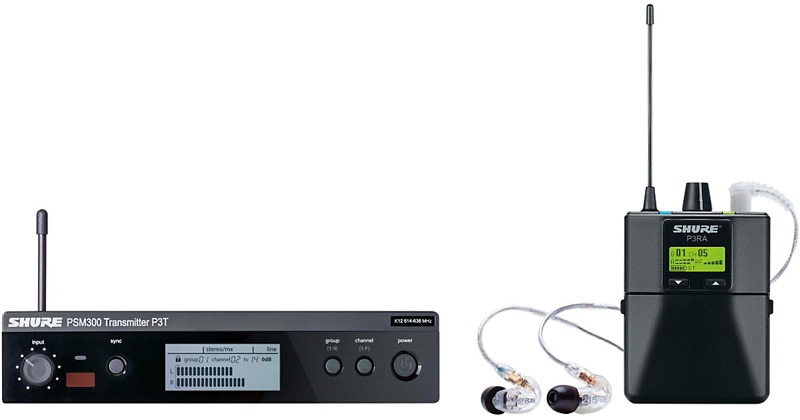
Shure makes setup and use of the PSM 300 Stereo Personal Monitoring System a no-brainer while 24-bit digital technology delivers clear, highly detailed sound.
IEMs have increased in popularity due to improvements in technology and their increased affordability. You’ve probably noticed that many major artists now use IEMs, and they’re likely to be a sound investment if you perform frequently and find hauling floor monitors to be a hassle. For more information on IEMs we invite you to call one of our friendly and knowledgeable Gear Heads at (877) 880-5907.
Things to Consider in Finding the Right Wireless System
Here’s a list of questions to answer that will help you zero in on the right wireless solution for your needs:
Where do plan to use the system?
If you’re going to use it in one fixed location, the considerations are pretty simple. Just be sure the system operates on VHF or UHF frequencies that won’t compete with local TV broadcasting or other wireless devices used in or near the location.
If you plan to use the wireless system in different cities and locations, a frequency-agile system will help you adapt to local conditions. Automatic frequency selection makes the process simpler.
How many wireless systems will be in use?
If your answer is one, then there’s no need for multi-system management.
If you’re going to use two or more wireless systems, each must be able to operate on a different frequency. Those frequencies should be chosen with care to prevent interference between systems. Better-quality systems help with these issues by automatically selecting compatible frequencies. UHF and VHF systems can usually be operated alongside each other without issues.
At Musician’s Friend we sell many combo wireless systems that include all the gear necessary to equip various combinations of performers such as a vocal/instrumental duo. These combo packages eliminate guesswork and potential incompatibilities, and can save you money.
Are there likely to be signal-path obstructions where you’ll use the system?
Diversity receivers, especially those with true diversity circuitry, will help prevent dropouts caused by physical obstructions and reflective surfaces.
We want you to be pleased with your wireless system purchase, and offer a generous return policy so you can order with confidence. After reading this guide, if you’re still not sure which system is right for you or need help selecting frequencies, we invite you to call one of our friendly and knowledgeable Gear Heads at (877) 880-5907.
Learn more about microphones of all types with our Microphone Buying Guide.





































































































































